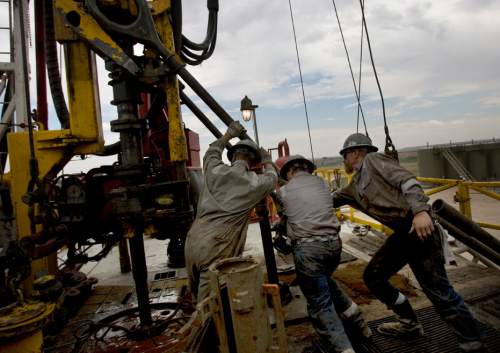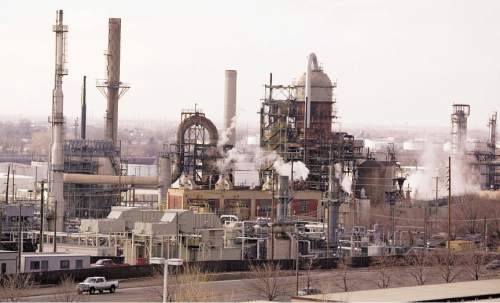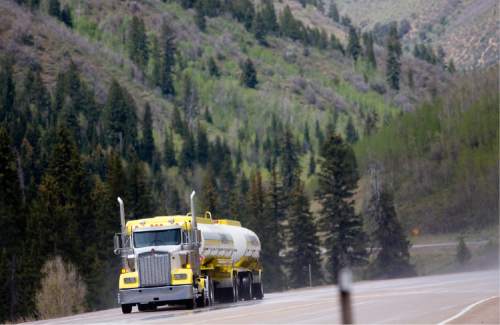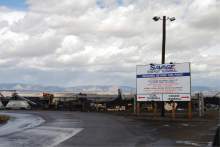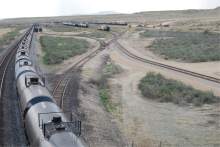This is an archived article that was published on sltrib.com in 2015, and information in the article may be outdated. It is provided only for personal research purposes and may not be reprinted.
The Uinta Basin's famous waxy crude set off an industry in northeastern Utah.
Since crews first discovered oil in 1951 at the Altamont field, daily production has surged to 90,000 barrels with new drilling technology and high prices. Utah's oil fields have yielded nearly 700 million barrels in all.
But the crude also presents a sticky transportation problem. The stuff congeals if it cools to about 110 degrees.
Three pipelines were proposed last year, as well as a rail line that would cost up to $5 billion to build. The projects were supposed to relieve the truck traffic that shuttles the yellow-and-black wax along U.S. Highways 191 and 40 and Interstate 80, and increase the value of the fuel, which is sold to Salt Lake refineries at a discount.
But those ambitions appear to be going dormant since the price of oil plunged several months ago. Many of the three dozen rigs drilling in Utah have been idled or moved out, and only a handful remain active in the basin.
Declining prospects for U.S. oil development seem to have quashed the transportation projects.
Citing "unfavorable market conditions," Tesoro put a "permanent hold" on the most developed of the three pipeline projects, the expensive Uinta Express Pipeline.
The company's buried, insulated, 16-inch pipeline would have moved 60,000 barrels a day from Myton to Salt Lake's refinery row — 135 miles.
"If there is not a supply, we can't subscribe that capacity," said Brad Shafer, Tesoro's senior manager for government and public affairs. "There is not the product to put in it. Even at high prices, it was marginal."
Tesoro's proposal had met stiff opposition from Summit County officials, who were concerned about the impacts of a pipeline rupture in the Weber River watershed.
Despite the setback, Duchesne and Uintah County officials remain eager to develop new pathways for their oil beyond "the expensive and slow process of trucking," according to Ralph Okerlund, a Republican state senator who heads the newly formed Six County Infrastructure Coalition.
In 2013, the Utah Department of Transportation released a study that found Uinta oil producers stand to lose $24 billion over the next decade due to inadequate transportation capacity.
"We have always been supportive of addressing that bottleneck," said Cody Stewart, Gov. Gary Herbert's energy adviser. "We thought the Tesoro idea was a good one.
"There is a product there," Stewart added. "We would like to see it have access to as many markets as possible."
At the time Tesoro proposed its pipeline, daily Uinta production was expected to increase to 137,000 barrels by 2022 and the line was projected to do the work of 250 truck trips each day.
But moving the oil by pipe requires costly interventions.
There are three potential ways to do it, according to Scott Hill, a Utah State University chemical engineer. Uinta's waxy crude can be heated, diluted with solvents or more fluid types of oil, or "cracked," which entails breaking up the long molecule chain associated with its paraffin content so that it can flow at lower temperatures.
The Tesoro line would likely have deployed heat tracers and heated storage tanks en route.
Two other pipeline proposals would deliver oil not to Salt Lake area refineries, which enjoy bargain prices because Uinta producers have few other places to take their oil. The lines would tap rail connections to the south, so the oil could be shipped to new refining destinations via a massive tank farm at Cushing, Okla.
The $115 million DC Express would pour up to 120,000 barrels a day in a buried, unheated, 20-inch pipeline near Myton and move it 70 miles over the Book Cliffs to new load-out facilities on a rail line at Wellington.
The project, under development by a Lehi-based firm called 670, LLC would "upgrade" the waxy crude using a proprietary technology developed by Applied Research Associates, according to a presentation 670 principal Mike Roberts made to the Duchesne County Commission last January. Workers would crack the crude just enough so that it can be piped, yielding a "syncrude" product Roberts' dubbed "Uinta Basin Super Sweet."
On land it owns near Myton, the firm would build a $70 million upgrader plant, which would initially process up to 10,000 barrels a day.
The pipeline would largely follow existing roads, such as Wells Draw and Gates Canyon. Roberts' firm had 70 percent of the rights-of-way secured across private land, he told the commission. For public lands, a right-of-way application is pending with the Bureau of Land Management, which initiated an environmental review last November.
Roberts predicted the BLM would sign off on the project sometime this summer. The line would be complete in 2016, after six months of construction.
However, agency officials this week said they cannot begin public scoping until they receive a formal proposal from the company.
Roberts did not respond to e-mail or phone messages.
The Texas-based energy firm Summit Midstream Partners is investigating whether to construct a hot-oil line from a truck uploading station at Ouray to a rail load-out in Fruita, Colo., according to the Hill study. That 16-inch line would move up to 90,000 barrels a day.
The Hill report pegged the Uinta Basin's remaining reserves at 441 million barrels.
Chevron maintains twin pipelines across the basin, delivering oil from Rangely, Colo., to its Salt Lake refinery. One is idled and some Uinta crude is injected into the active one.
Waxy stuff from the Red Wash field can remain liquid when mixed with the other oil as it travels through the 10-inch pipe. The concentration of Uinta wax in the line today is about 5 percent, but was as high as 25 percent in the summer months, and 10 percent in winter, according to Hill's study.
Those past practices demonstrate the perils of moving high levels of untreated waxy crude via pipeline. The oil can harden if its movement is interrupted.
"If you lose the power to that, you have a 20-mile candle," Hill said.
That has happened twice before.
During a cold snap in 1963, oil congealed in the line, requiring a five-mile stretch to be dug up and replaced. Chevron then installed three heating stations.
In 1980, a 22-mile stretch went solid between Woodland and Kimball Junction. The line was shut down for an entire summer for repairs. This is the same pipeline that ruptured in Salt Lake City's foothills in 2010, spilling 54,600 gallons into Red Butte Creek and fouling Liberty Park's pond for months.
Chevron stopped using the heaters and now moves much smaller amounts of waxy crude.


